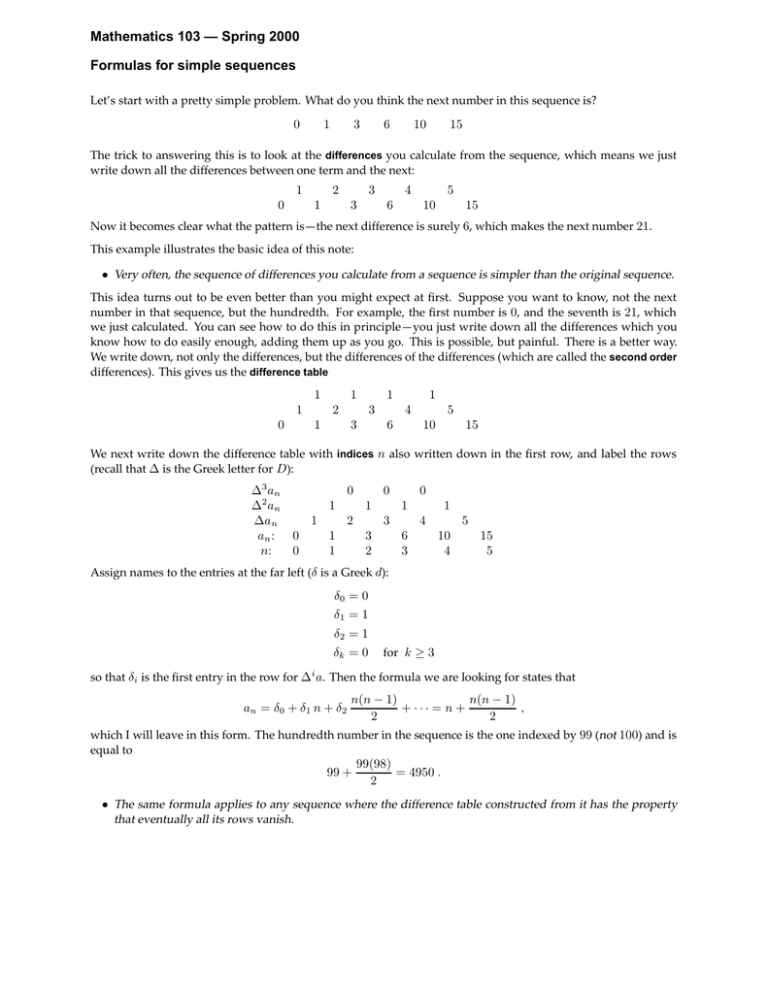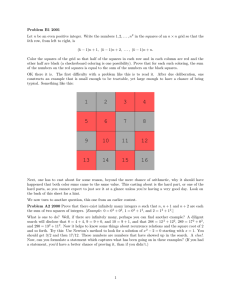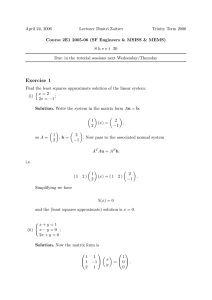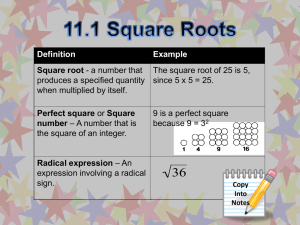Mathematics 103 — Spring 2000 Formulas for simple sequences
advertisement

Mathematics 103 — Spring 2000 Formulas for simple sequences Let’s start with a pretty simple problem. What do you think the next number in this sequence is? 0 1 3 6 10 15 The trick to answering this is to look at the differences you calculate from the sequence, which means we just write down all the differences between one term and the next: 0 1 1 2 3 3 6 4 10 5 15 Now it becomes clear what the pattern is—the next difference is surely 6, which makes the next number 21. This example illustrates the basic idea of this note: • Very often, the sequence of differences you calculate from a sequence is simpler than the original sequence. This idea turns out to be even better than you might expect at first. Suppose you want to know, not the next number in that sequence, but the hundredth. For example, the first number is 0, and the seventh is 21, which we just calculated. You can see how to do this in principle—you just write down all the differences which you know how to do easily enough, adding them up as you go. This is possible, but painful. There is a better way. We write down, not only the differences, but the differences of the differences (which are called the second order differences). This gives us the difference table 0 1 1 1 2 1 3 3 1 6 4 1 10 5 15 We next write down the difference table with indices n also written down in the first row, and label the rows (recall that ∆ is the Greek letter for D): ∆3 an 0 0 0 1 1 1 1 ∆2 an ∆an 1 2 3 4 5 an : 0 1 3 6 10 15 n: 0 1 2 3 4 5 Assign names to the entries at the far left (δ is a Greek d): δ0 = 0 δ1 = 1 δ2 = 1 δk = 0 for k ≥ 3 so that δi is the first entry in the row for ∆i a. Then the formula we are looking for states that n(n − 1) n(n − 1) + ··· = n + , 2 2 which I will leave in this form. The hundredth number in the sequence is the one indexed by 99 (not 100) and is equal to 99(98) = 4950 . 99 + 2 an = δ 0 + δ 1 n + δ 2 • The same formula applies to any sequence where the difference table constructed from it has the property that eventually all its rows vanish. A more complicated example 2 A more complicated example Suppose we want to find a formula for the n-th number in thjis sequence: 1 1 2 5 11 21 36 We fill in the difference table until we get a row of zeroes: 1 1 0 0 1 2 1 1 an : 1 n: 0 1 0 1 1 We have 1 1 0 2 2 2 3 0 6 5 3 6 10 11 1 3 1 4 6 5 1 0 1 3 3 2 Add the indices: 0 1 0 4 11 4 15 21 1 10 6 21 5 15 36 36 6 δ0 = 1 δ1 = 0 δ2 = 1 δ3 = 1 δk = 0 for k ≥ 4 and the formula we get is an = δ 0 + δ 1 n + δ 2 n(n − 1) n(n − 1)(n − 2) n(n − 1) n(n − 1)(n − 2) + δ3 + ··· = 1 + + , 2 2·3 2 6 You can check this by setting n = 0, n = 1, n = 2. The technique explained here for finding such a formula due, I believe, to Isaac Newton. It works in very general circumstances. One more example Let’s suppose we want to find a formula for the sum of the first n squares 1 + 4 + 9 + · · · + n2 . The first few sums, for example, are given by this table: n n2 sum of first n squares 1 1 1 2 4 5 3 9 14 4 16 30 5 25 55 6 36 81 There is a simple trick to be done first. What if n = 0? What is the sum of the first 0 squares? The sum of the first n squares is the sum of n numbers, and if we are summing no numbers at all, the answer has to be 0. We take this into account, and rewrite the relevant part of our table like this: One more example 3 0 0 n sum of first n squares 1 1 2 5 3 14 4 30 5 55 6 81 So, we are looking again at our original problem. Except that from one sequence, that of squares, we have constructed a new sequence, that of the sums of terms from the original one. It is this new sequence for which we want a formula. So now we write down the difference sequence, which is of course just the sequence of squares itself. 1 0 4 1 5 9 14 16 30 25 55 36 81 Then take the differences of that in turn. 3 1 0 5 4 1 5 9 7 14 16 9 30 25 11 55 36 81 Keep on doing this. You eventually arrive at a row of all zeroes. Stop there. In this case we have then 0 1 3 1 2 4 0 5 5 2 9 0 7 14 2 16 0 9 30 2 25 0 11 55 2 36 13 81 49 130 The important numbers in this table are the ones at the far left, the ones labeled by δ ’s: δ4 = 0 0 0 0 δ3 = 2 2 2 2 2 δ2 = 3 5 7 9 11 13 4 9 16 25 36 49 δ1 = 1 δ0 = 0 1 5 14 30 55 81 130 Then the formula we are looking for is δ0 · 1 + δ1 · n + δ2 · n(n − 1) n(n − 1)(n − 2) n(n − 1)(n − 2)(n − 3) + δ3 · + δ4 · + ··· 2 6 24 Incidentally, in order to work with this, you have to know how to generate the denominators 1, 2, 6, 24, etc. These are the factorials n! for n = 1, n = 2, etc. To be precise, the factorial n! is the product of all the first n integers, so that 1! = 1, 2! = 1 · 2 = 2, 3! = 1 · 2 · 3 = 6, . . . , n! = 1 · 2 · 3 · · · · n . The pattern here should be pretty clear. The next denominator, for example, would be 5! = 5 · 4! = 120. These same expressions in n occur in many other places. In our case the formula gives us 0·1+1·n+3· n(n − 1)(n − 2) n(n − 1) +2· 2! 3! Notice that we do not have to simplify this formula by combining terms. It is useful as it stands. And, of course, when you are through you can check easily enough whether your formula is correct by comparing a few values with the sequence you started with. This works for finding the sum of the first k -powers, for any positive k , because as you can verify easily enough by experiment, its k + 1-differences are constant and the k + 2-differences are all 0. Exercise 1. Write down the difference table for the k -th powers a 1 = 1k , a2 = 2k , a3 = 3k , etc. up to k = 4 and n = 6. Guess what the row of k -th order differences will be in general. What if the first index is not 0? 4 Exercise 2. Find the formula for a n in this case: 0 1 n: an : 1 5 2 11 3 19 4 29 5 41 4 106 5 187 Exercise 3. Find the formula for a n in this case: n: an : 0 2 1 7 2 22 3 53 Exercise 4. Find a formula for the sum of the first n cubes 1 + 8 + 27 + · · · + n 3 . What if the first index is not 0? This is easy to deal with. Suppose, for example, that we had not thought of the trick of summing 0 terms. We would be faced with the table 1 1 n sn 2 5 3 14 4 30 5 55 6 81 The trick now is to make up a new sequence, call it tn , with t0 = s1 , t1 = s2 . Etc. Thus tn = sn+1 . We can find the rule for tn by the procedure outlined above. But then s n = tn−1 , so we just substitute n − 1 for n in this formula. Exercise 5. Find the formula for a n in this case: n: an : 1 2 2 7 3 22 4 53 5 106 6 187 Exercise 6. Let a n be the sum of the first n powers of 2 20 + 21 + · · · + 2n−1 . Thus a1 = 1, a2 = 3, a3 = 7, etc. What is the row of differences? For what value of k will the k -th differences all be 0? Write down a simple formula for an .






